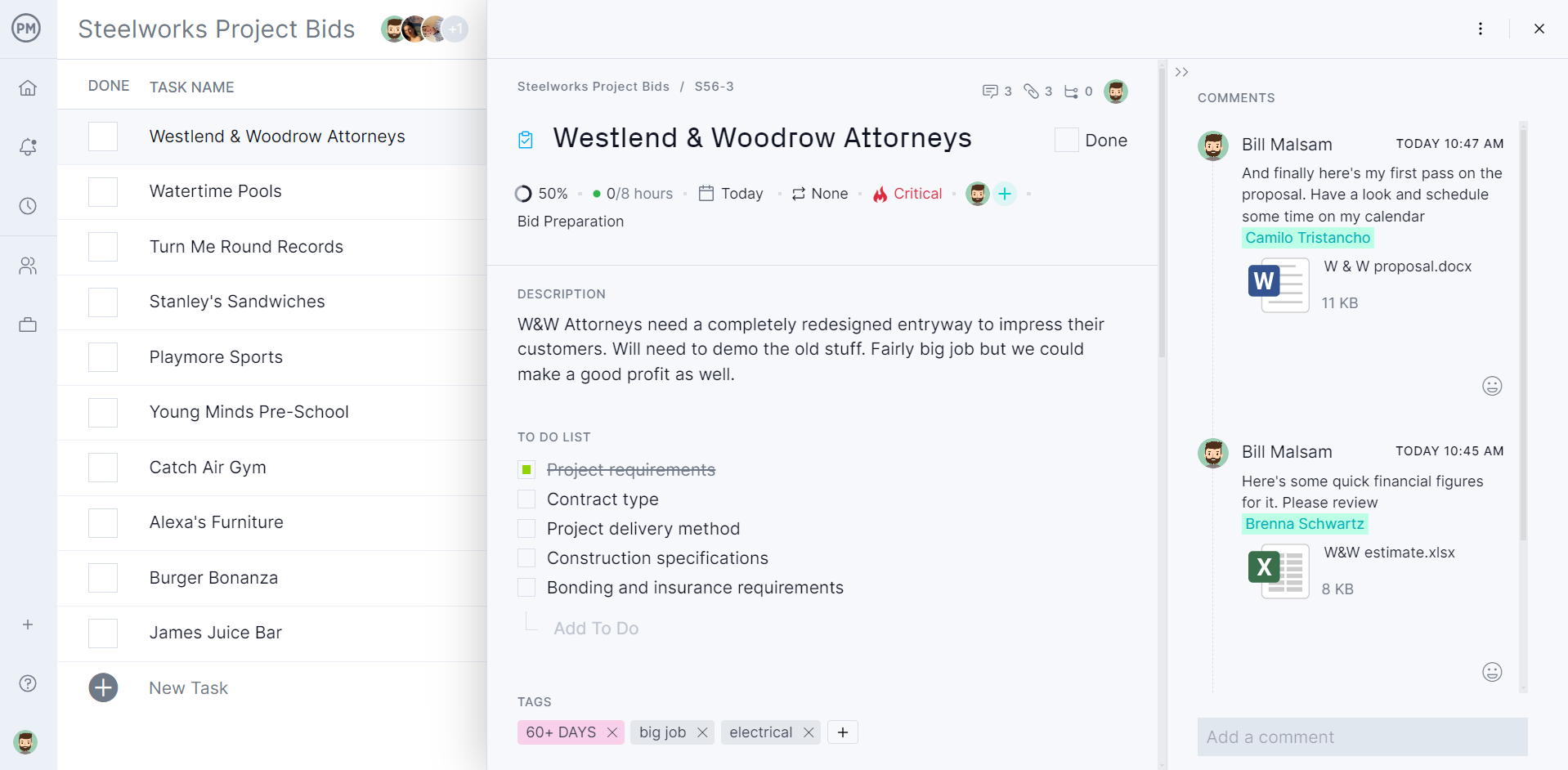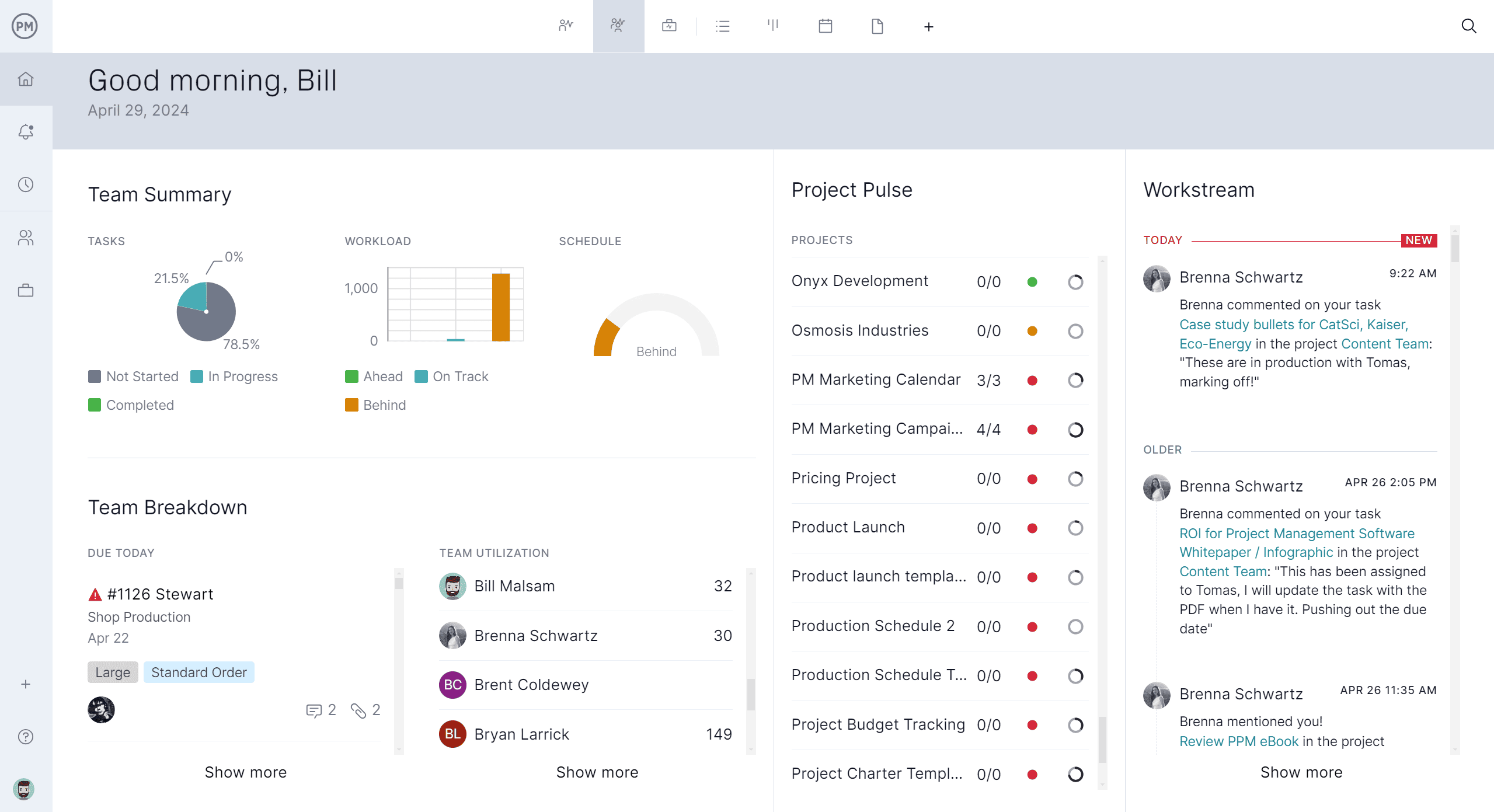This blog provides a detailed analysis of a project plan for constructing a five-story hotel building.
The project management plan example below showcases all the key components of a professional project plan, including the purpose, goals, scope, budget, schedule, risk management, quality standards and stakeholder engagement strategies.
We use realistic sample data to support each section in this project management plan example to illustrate how to effectively document and manage a construction project from start to finish. Whether you’re learning how to create a project plan or seeking inspiration for your own, this example offers a comprehensive and practical reference for project planning.
Before diving into a project management plan example, it’s important to understand why project management software is essential to a plan’s success. It centralizes all project elements—tasks, timelines, resources and risks—into one collaborative workspace. This ensures transparency, improves communication and enables real-time updates that keep everyone aligned and accountable. By automating scheduling, tracking and reporting, project management software eliminates guesswork and helps teams adapt quickly to change, which is critical for staying on track and delivering results.
ProjectManager is award-winning project and portfolio management software with Gantt charts that are especially effective for project planning because they combine visual scheduling with powerful automation and collaboration tools. You can create task dependencies, set milestones and define a critical path—all within an interactive timeline that updates in real time.
Drag-and-drop functionality makes adjusting plans simple and intuitive, while built-in workload tracking and baselining ensure that your team stays productive and your project remains within scope and budget. Whether planning a simple timeline or managing a complex project, our Gantt chart gives you full control. Get started with ProjectManager today for free.
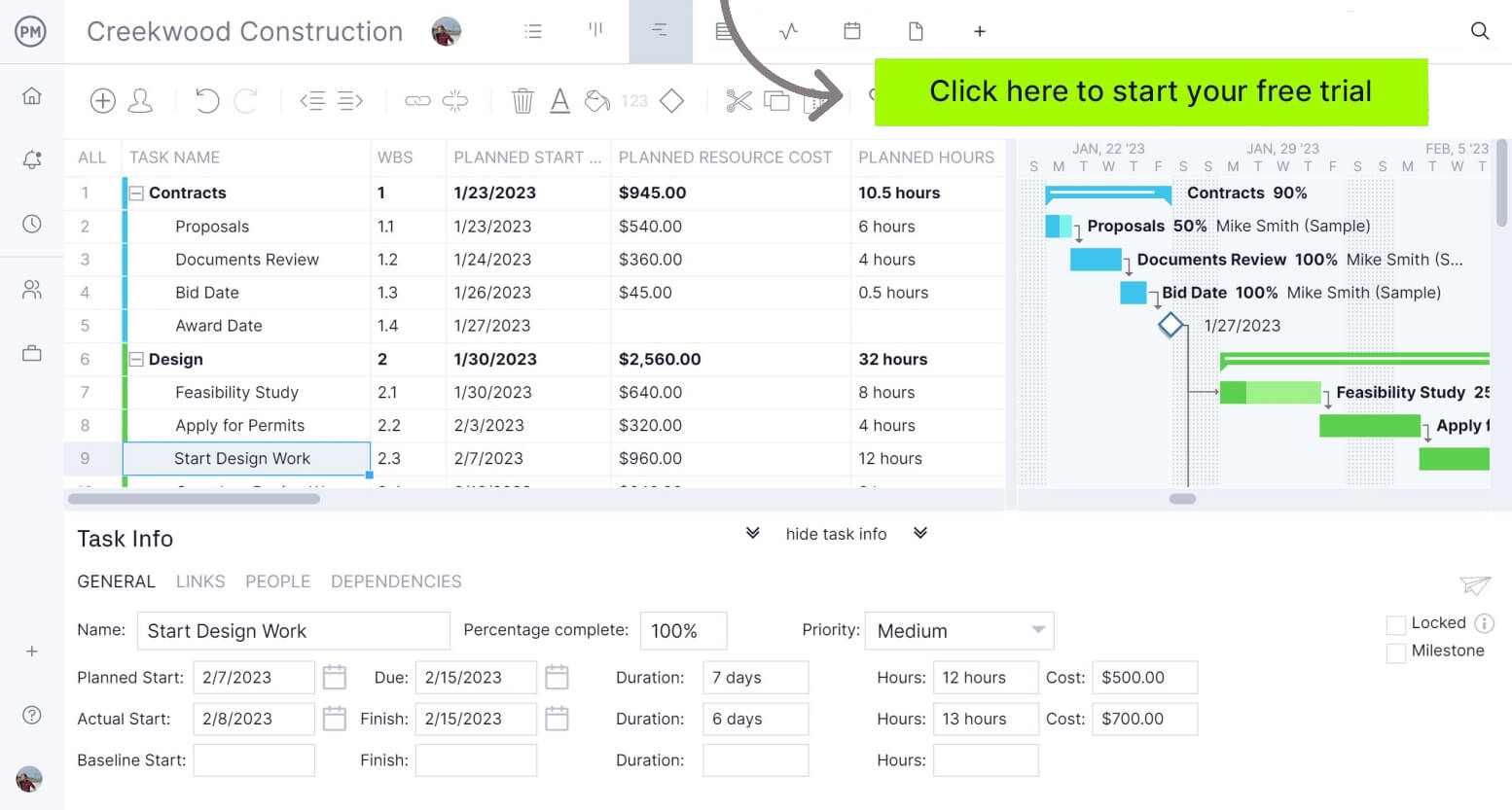

Project Management Plan Example
Imagine a large hotel chain that’s building a new five-story hotel to expand its operations in a new territory.
The project involves the construction of a modern, five-story hotel in the heart of a growing urban district. Designed to attract both business and leisure travelers, the hotel will feature 120 guest rooms, a rooftop terrace, conference facilities, a restaurant and underground parking. The building will incorporate energy-efficient systems and contemporary design elements aligned with the client’s brand standards.
Construction is scheduled to begin in January and be completed within 18 months, with a total budget of $15 million. The project team will coordinate closely with stakeholders to ensure the hotel meets quality, schedule, and regulatory requirements while minimizing disruptions.
To keep things simple, we’ve summarized certain elements of the subsidiary plans within this project management plan, while keeping the most important elements. Here’s what the project management plan for this project will look like.
1. Project Purpose, Goals and Objectives
A project purpose is a concise statement explaining why the project exists and what it aims to achieve at a high level. It provides the overall justification for initiating the project and connects its outcomes to broader organizational needs or strategic priorities. The project purpose helps stakeholders understand the intended impact and long-term value, guiding decision-making and alignment throughout the project lifecycle.
Project goals and objectives define the specific outcomes a project is expected to achieve. Goals are broad, strategic targets that reflect the desired end state, while objectives are measurable steps that support reaching those goals. Together, they provide direction, establish performance benchmarks and guide planning and execution. Clear goals and objectives ensure that everyone involved understands what success looks like and how progress will be tracked throughout the project.
The image below shows the project purpose, goals and objectives for this project management plan example.
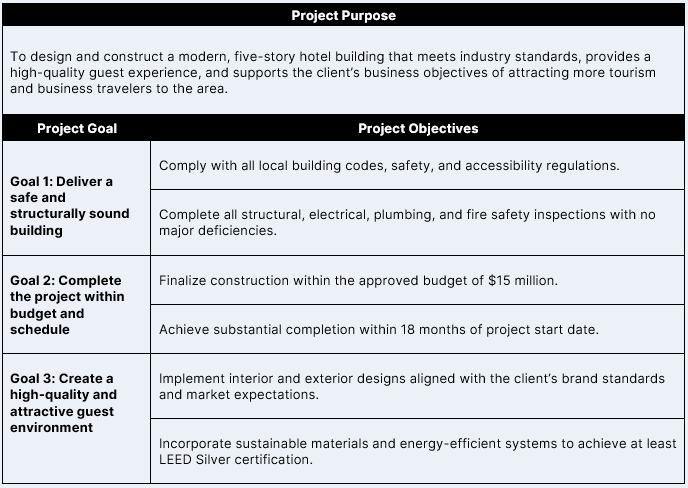

2. Project Success Criteria
Project success criteria are the specific benchmarks used to determine whether a project has met its intended outcomes. These criteria may include completing the project on time, staying within budget, meeting scope and quality standards or satisfying stakeholder expectations. They provide a clear, objective way to measure performance and guide decision-making during and after the project. Defining success criteria early ensures alignment across teams and helps evaluate the project’s effectiveness once it concludes.
The image below shows the project success criteria for this project management plan example.
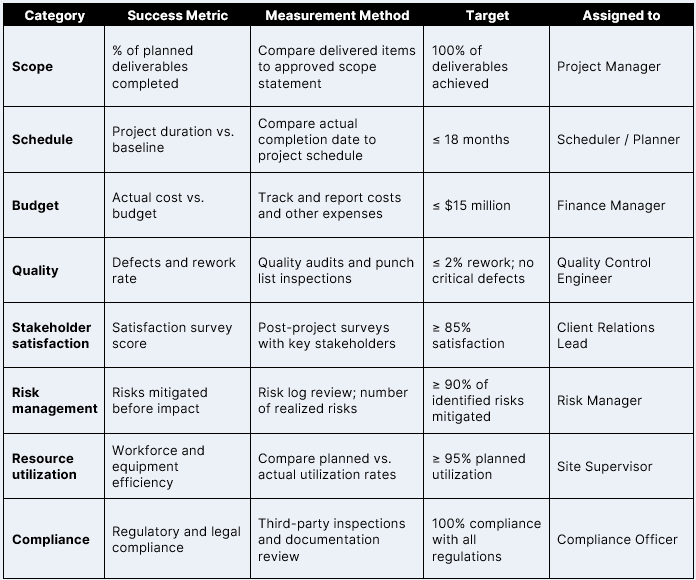

3. Project Management Team
A project management team is a group of individuals responsible for planning, executing and overseeing all aspects of a project from start to finish. Led by the project manager, this team typically includes specialists in scheduling, budgeting, risk management, communication and quality control. The team works collaboratively to ensure the project meets its goals, stays within scope and aligns with stakeholder expectations. Their coordination and expertise are critical to delivering successful project outcomes.
The image below shows the project management team roles and responsibilities for this project management plan example.
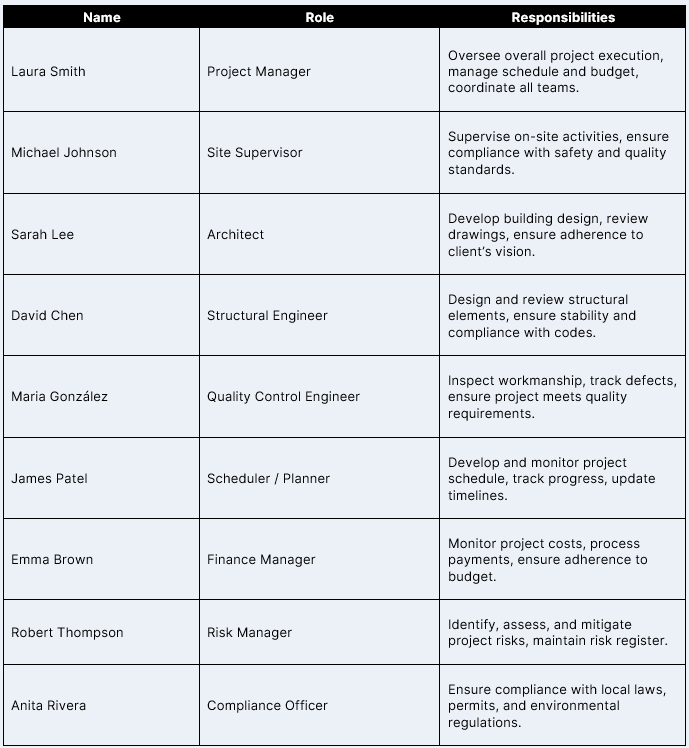

4. Project Governance
Project governance is the framework that defines how decisions are made, monitored and enforced throughout a project’s lifecycle. It outlines roles, responsibilities, processes and policies to ensure accountability, transparency and alignment with organizational goals. Project governance helps manage risks, resolve conflicts and ensure that resources are used effectively. By providing clear oversight and structure, it supports consistent decision-making and increases the likelihood of project success.
The image shows the project governance structure for this project management plan example.
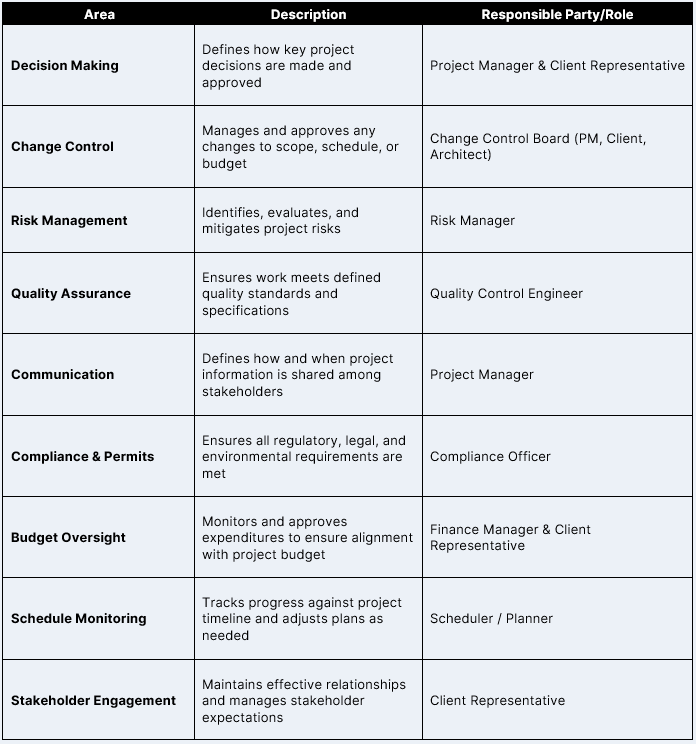

5. Stakeholder Management Plan
A stakeholder management plan is a strategic document that outlines how a project team will identify, engage and communicate with stakeholders throughout the project lifecycle. It defines each stakeholder’s level of influence, interests and communication needs, then details the strategies for managing expectations and maintaining strong relationships. This plan ensures consistent engagement, reduces misunderstandings and helps build support for the project, ultimately contributing to smoother execution and higher chances of success.
These are the key elements of a stakeholder management plan.
1. Stakeholder Identification
- Stakeholders were identified during the planning phase and recorded in the stakeholder register, which includes their roles, power, interest and contact information.
- Key stakeholders include the client representative, project team members, regulators, local community members and vendors.


2. Stakeholder Analysis
- Stakeholders were analyzed based on their power to influence the project and their interest in its outcome.
- This analysis categorized stakeholders into engagement strategies, such as manage closely, keep satisfied, keep informed, or monitor.
3. Engagement Strategies
- Tailored strategies were developed for each key stakeholder to ensure appropriate communication and involvement. For example:
- The client representative is engaged through weekly meetings and milestone approvals.
- Local businesses and community members are kept informed through monthly newsletters and notices.


4. Communication & Reporting
- The communication plan defines the frequency, method and content of communication with each stakeholder group.
- Regular updates, feedback sessions and formal reports ensure transparency and trust.
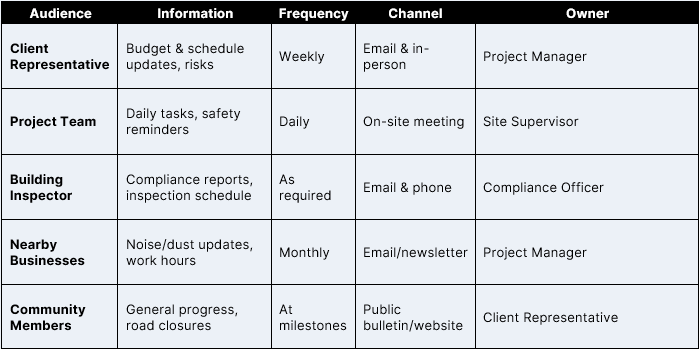

Related: 12 Free Report Templates
5. Roles & Responsibilities
- Project Manager: Oversees stakeholder management and ensures concerns are addressed.
- Client Representative: Provides feedback and approvals on behalf of the client.
- Team Members: Engage with stakeholders within their area of responsibility and escalate issues as needed.
6. Monitoring & Review
- Stakeholder needs and engagement effectiveness will be reviewed periodically.
- The stakeholder register and engagement strategies will be updated as the project progresses to reflect any changes.
6. Scope Management Plan
A scope management plan is a component of the overall project plan that outlines how the project scope will be defined, validated and controlled. It details the processes for documenting requirements, creating the scope statement and work breakdown structure (WBS), and managing scope changes. The plan ensures that all project work—and only the required work—is included, helping prevent scope creep and keeping the project aligned with its goals, timeline and budget.
Here are the key elements of the scope management plan for this project management plan example.
1. Scope Definition
- The scope was defined collaboratively with the client and stakeholders, documented in the scope baseline, which includes the scope statement, work breakdown structure (WBS) and WBS dictionary.
- Key deliverables include site preparation, foundation, structural framing, exterior enclosure, MEP systems, interior finishes, landscaping, and final inspection.
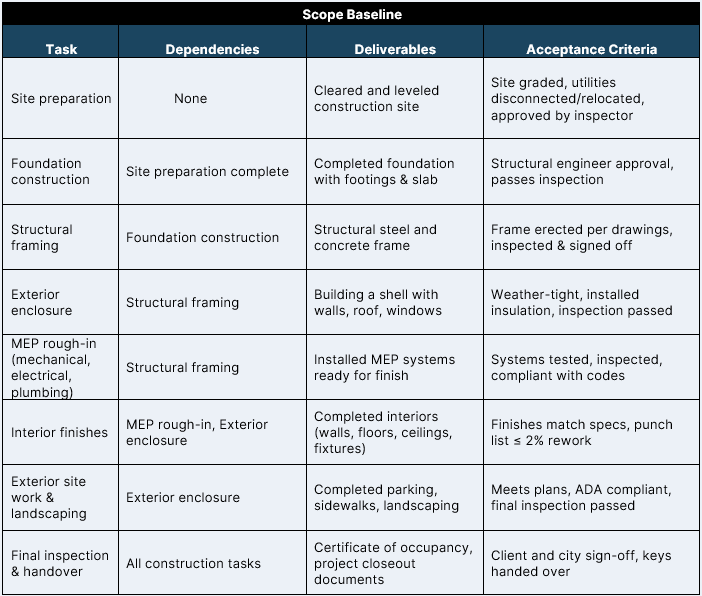

2. Scope Validation
- Completed deliverables will be reviewed against the scope statement and acceptance criteria.
- Formal sign-off from the client or designated representative is required before a deliverable is considered complete.
3. Scope Control
- Any proposed changes to scope will follow the change management process and must be approved by the Change Control Board (CCB) before implementation.
- Scope creep will be monitored and managed through regular reviews and comparison to the scope baseline.
4. Roles & Responsibilities
- Project Manager: Ensures all scope activities are properly defined, executed, and controlled.
- Client Representative: Reviews and approves deliverables and any requested scope changes.
- Team Members: Deliver their assigned tasks according to the approved scope and report any deviations.
5. Assumptions, Constraints & Exclusions
- The scope baseline includes documented assumptions, constraints and exclusions to clarify what is and isn’t part of the project.


7. Resource Management Plan
A resource management plan is a document that outlines how all project resources—such as people, equipment, materials and budget—will be acquired, allocated, managed and monitored throughout the project. It defines roles and responsibilities, resource availability, workload distribution and strategies for resolving conflicts or shortages. This plan ensures resources are used efficiently, supports accurate scheduling and helps keep the project on track by aligning resource usage with project goals and constraints.
Here are the key elements of the resource management plan for this project management plan example.
1. Resource Planning
- Resource requirements are identified based on the project scope, schedule, and deliverables.
- A resource requirements table lists the resources needed for each major task, including labor, materials, and equipment.
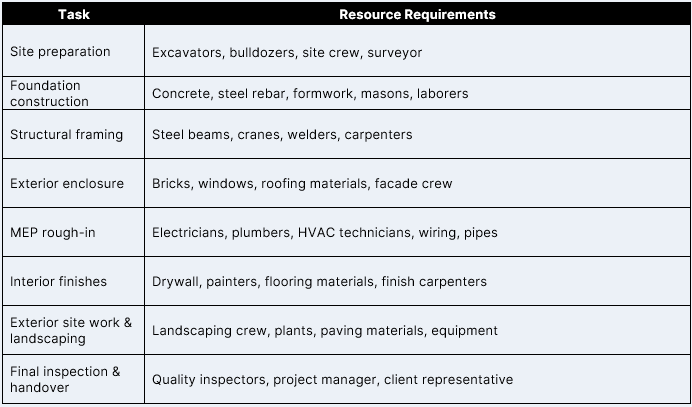

2. Resource Acquisition
- Skilled labor, subcontractors and equipment will be procured through prequalified vendors and competitive bidding when necessary.
- Materials will be ordered according to the procurement schedule to align with construction phases and minimize storage costs.
3. Roles & Responsibilities
- Project Manager: Oversees overall resource planning and allocation.
- Site Supervisor: Manages daily labor assignments, equipment use, and material deliveries on site.
- Finance Manager: Ensures resource costs remain within budget.
- Team Members & Subcontractors: Execute assigned tasks and report resource needs/issues.
4. Resource Allocation & Optimization
- Labor, equipment and materials will be allocated based on task priorities and availability.
- Resource utilization will be monitored weekly to avoid underuse or bottlenecks.
- Adjustments will be made proactively to address delays, shortages or surpluses.
5. Monitoring & Control
- The Project Manager and Site Supervisor will monitor resource performance against the plan using regular site reports and resource tracking tools.
- Any significant variances will be analyzed and corrective actions will be implemented promptly.
Related: 7 Free Resource Management Templates
8. Project Schedule
A project schedule is a detailed timeline that outlines when project tasks and milestones will be started and completed. It includes activity durations, dependencies and deadlines, providing a roadmap for managing time and coordinating team efforts. A well-structured project schedule helps identify the critical path, allocate resources effectively and monitor progress against the plan. Organizing work chronologically and setting clear expectations enables project managers to keep the team aligned and ensure the timely delivery of the project’s objectives.
Here’s the project schedule for this project management plan example.
A project schedule often mimics a Gantt chart because both lay out tasks along a timeline, showing start and end dates, durations and dependencies. This visual format makes it easy to track progress, spot delays and adjust plans as needed. Gantt charts are especially valuable for construction projects because they handle complex sequences of tasks, highlight the critical path and integrate with resource management. Their clarity and real-time updates help coordinate crews, subcontractors and materials across multiple phases of work.
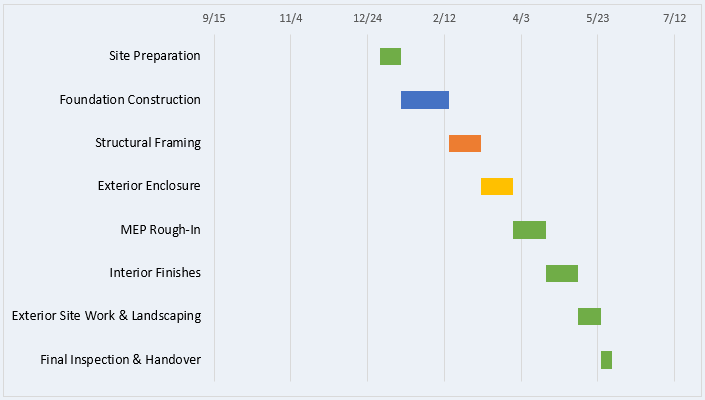

9. Project Budget
A project budget is a detailed estimate of all costs required to complete a project successfully. It includes expenses such as labor, materials, equipment, overhead and contingency reserves. The budget serves as a financial plan that guides spending, supports resource allocation and helps monitor actual costs against forecasts. Maintaining an accurate project budget is essential for controlling expenses, securing stakeholder approval and ensuring the project delivers value within its financial constraints.
Here’s the project budget for this project management plan example.
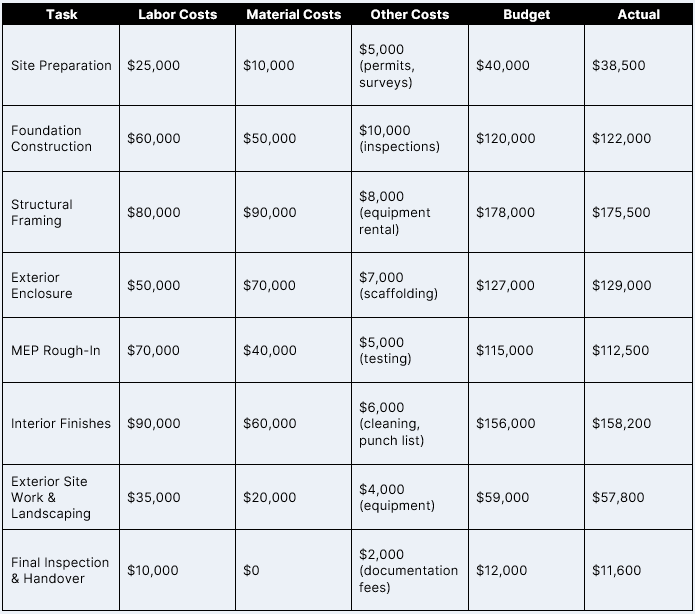

10. Cost Management Plan
A cost management plan is a document that outlines how project costs will be planned, estimated, budgeted, monitored and controlled. It defines procedures for tracking expenditures, managing cost variances and approving changes to the budget. This plan ensures that the project stays financially on track by providing guidelines for cost forecasting, reporting and risk management. Establishing clear cost controls helps prevent overruns and supports informed decision-making throughout the project lifecycle.
Here are the key elements of the cost management plan for this project management plan example.
1. Cost Estimation Methodology
Costs for each task are estimated using a combination of analogous estimating (based on similar past projects) and bottom-up estimating (summing detailed task-level costs for labor, materials and other expenses). This approach balances accuracy with efficiency and provides a reliable budget baseline.
2. Budget Development
The project budget is developed by aggregating task-level estimates and adding a contingency reserve of 10% to cover unforeseen costs. The budget is reviewed and approved by the client before construction begins.
3. Cost Monitoring & Control
The project team will use the following tools and techniques to monitor and control costs:
- Earned Value Management (EVM): To measure cost and schedule performance against the plan.
- Variance Analysis: To identify and address deviations from the budget.
- Cost Baseline Tracking: To compare actual expenses to the approved baseline.
- Cost Reports & Trend Analysis: To keep stakeholders informed of financial status and forecast future costs.
Monthly budget status reports will be provided to the client, and any significant cost changes will require formal approval through the change control process.
4. Roles & Responsibilities
- Project Manager: Oversees cost planning and control, and reports to stakeholders.
- Finance Manager: Tracks actual expenses, processes payments, and maintains records.
- Client Representative: Reviews and approves major cost changes.
11. Change Management Plan
This key project document defines how costs will be planned, estimated, budgeted and controlled throughout the project. The change management plan outlines the processes for monitoring expenses, managing cost variances and approving budget changes. The plan ensures financial discipline by setting clear guidelines for cost tracking and reporting. By providing structure to manage project finances, it helps prevent cost overruns, supports accurate forecasting and enables informed decision-making to keep the project within its approved budget.
Here are the key elements of the change management plan for this project management plan example.
The change management plan defines how proposed changes to the project scope, schedule, budget, or quality will be documented, evaluated, approved, and implemented to ensure controlled and transparent decision-making.
1. Change Identification
- Any team member, stakeholder or client can propose a change by submitting a formal change request.
- Change requests must include a description of the change, reason and expected impact on the project.
2. Change Evaluation
- The Project Manager will assess the change’s impact on scope, schedule, budget, risks, and quality.
- Input from relevant team members (e.g., Architect, Finance Manager, Risk Manager) will be gathered to evaluate feasibility and implications.
3. Approval Process
- All change requests will be reviewed and decided by the Change Control Board (CCB).
- The CCB may approve, reject or request additional information before making a decision.
- Approved changes will be documented and the project baseline(s) updated accordingly.
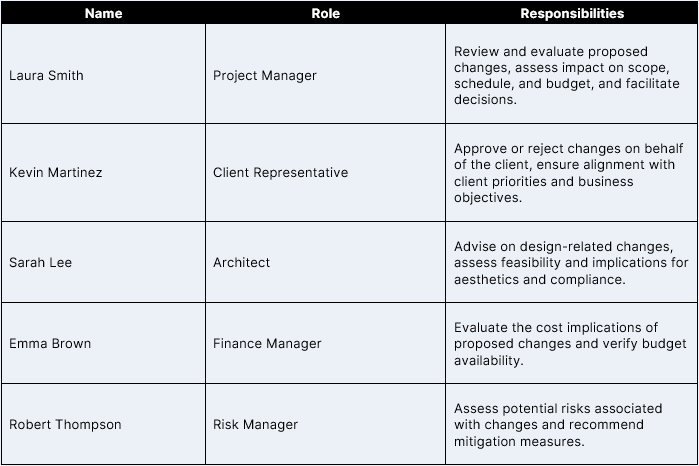

4. Implementation & Communication
- Once approved, the Project Manager will update the project plan, communicate the change to all affected parties and monitor implementation.
- Changes and their statuses will be logged in the Change Log for transparency and future reference.
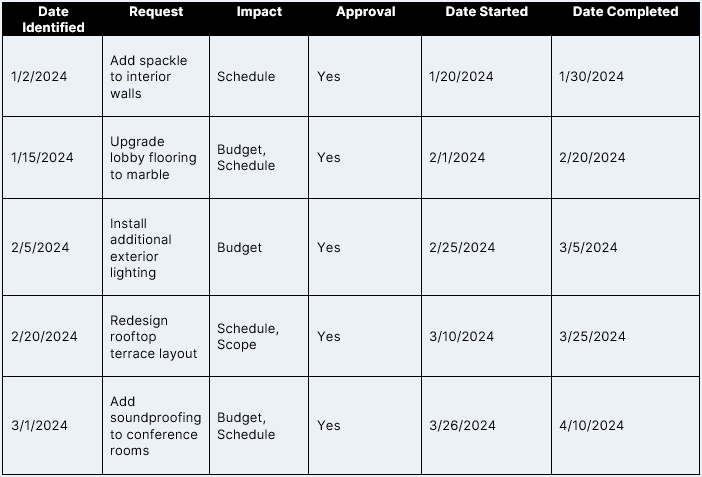

5. Roles & Responsibilities
- Project Manager: Facilitates the change management process, evaluates impacts, and implements approved changes.
- Change Control Board (CCB): Reviews and approves/rejects proposed changes.
- Team Members & Stakeholders: Provide input on proposed changes and implement tasks as needed.
12. Risk Management Plan
A risk management plan is a document that outlines how potential project risks will be identified, assessed, monitored and mitigated. It includes risk categories, impact analysis, response strategies and roles responsible for managing risks. This plan helps anticipate challenges that could affect scope, schedule, cost or quality. By proactively addressing uncertainties, the risk management plan improves decision-making, enhances preparedness and increases the likelihood of project success by minimizing disruptions and ensuring a structured approach to handling unexpected events.
Here are the key elements of the risk management plan for this project management plan example.
1. Risk Identification
- Risks will be identified at the planning stage and continuously during execution through team workshops, expert input and stakeholder feedback.
- A risk log will document each risk with its likelihood, impact, owner, and response plan.
2. Risk Analysis
- Risks will be assessed qualitatively based on likelihood (high, medium, low) and impact (cost, schedule, scope, quality).
- High-priority risks may also be analyzed quantitatively to estimate potential cost or schedule impacts.
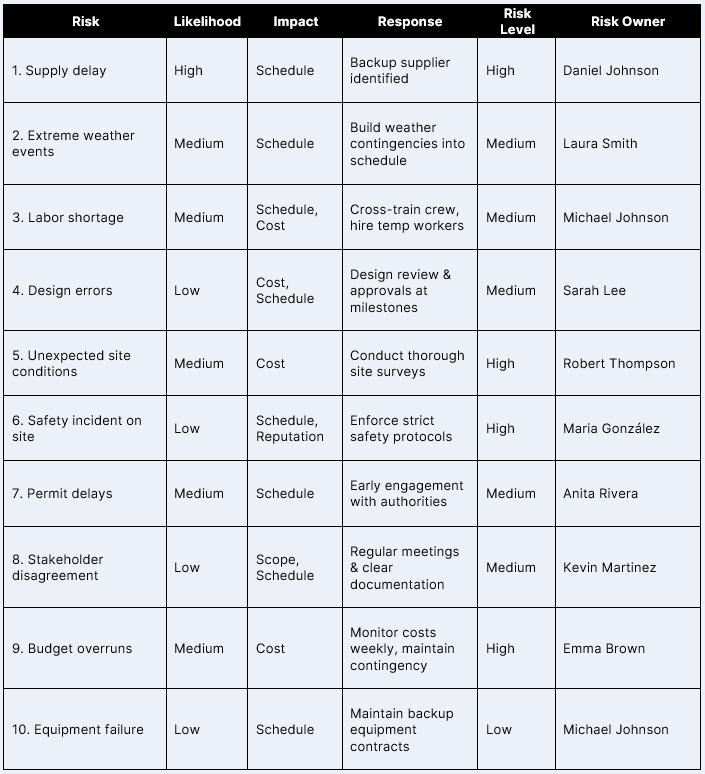

3. Risk Response Planning
For each identified risk, the team will define an appropriate response strategy.
- Mitigation: Reduce the probability or impact.
- Avoidance: Eliminate the risk.
- Transfer: Shift the impact to a third party (e.g., insurance).
- Acceptance: Acknowledge the risk and monitor it.
4. Risk Monitoring & Control
- The Project Manager and Risk Manager will review the risk log weekly, updating statuses and monitoring the effectiveness of response plans.
- New risks or changes to existing risks will go through the same identification and analysis process.
5. Roles & Responsibilities
- Risk Manager: Maintains the risk log, facilitates reviews and ensures responses are implemented.
- Project Manager: Oversees the overall risk management process and escalates critical risks to the client when necessary.
- Team Members & Stakeholders: Responsible for reporting emerging risks and supporting mitigation actions.
13. Quality Management Plan
A quality management plan is a document that defines how a project will achieve and maintain quality standards throughout its lifecycle. It outlines quality objectives, control processes, assurance activities and roles responsible for ensuring deliverables meet requirements. The plan includes methods for testing, inspections and compliance with industry or client standards. By providing a structured approach to quality, it helps prevent defects, ensures consistency and supports stakeholder satisfaction, contributing to the overall success and reliability of the project outcomes.
Here are the key elements of the quality management plan for this project management plan example.
1. Quality Objectives
- Deliver a structurally sound, code-compliant and aesthetically consistent hotel that meets the client’s brand and functional requirements.
- Minimize rework and defects through proactive planning, inspections and testing.
2. Quality Standards
- All work will comply with local building codes, industry standards, and the approved project specifications.
- Materials and workmanship will meet the standards defined in the quality baseline and contractual documents.
3. Quality Assurance
- Quality assurance activities focus on preventing defects by implementing processes, training and reviews.
- The Project Manager and Quality Control Engineer will conduct periodic audits, monitor subcontractors and ensure adherence to approved procedures.
4. Quality Control
- Quality control activities focus on identifying and correcting defects in completed work.
- Inspections, tests, and punch lists will be performed at key milestones (e.g., foundation, framing, MEP systems).
- Non-conformances will be documented, corrected, and verified before proceeding.
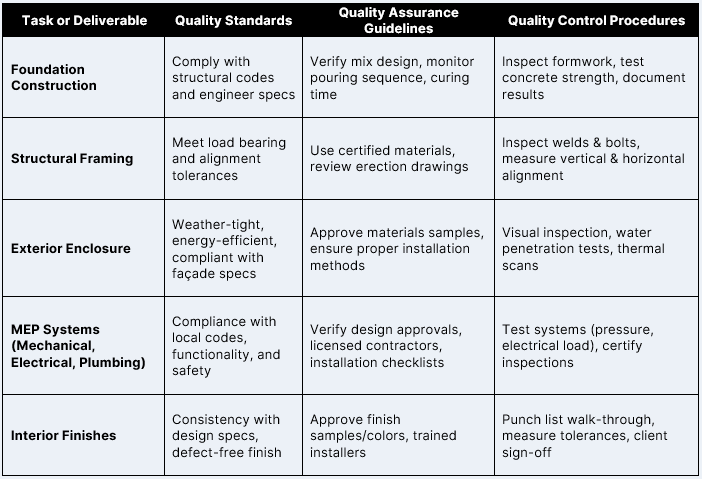

5. Roles & Responsibilities
- Project Manager: oversees quality planning and reporting.
- Quality Control Engineer: inspects work, documents findings, and coordinates corrective actions.
- Team Members & Subcontractors: responsible for delivering work according to specifications and reporting quality issues.
6. Tools & Techniques
- Checklists, inspection reports and material certifications.
- On-site testing (e.g., concrete strength, water tightness, system functionality).
- Client and third-party reviews for critical deliverables.
14. Procurement Management Plan
A procurement management plan outlines how goods and services required for a project will be acquired from external suppliers. It details procurement methods, contract types, vendor selection criteria, timelines and roles responsible for managing procurement activities. The plan ensures consistency and transparency in sourcing, helps mitigate supply chain risks and supports budget and schedule control. By clearly defining how procurement will be handled, it aligns purchasing with project needs and ensures the timely delivery of necessary resources and materials.
Here are the key elements of the procurement management plan for this project management plan example.
1. Procurement Approach
- Materials and services that cannot be produced in-house (e.g., steel beams, HVAC systems, specialized subcontractors) will be procured through competitive bidding where possible.
- Long-lead items will be identified early and ordered in advance to avoid schedule delays.
2. Vendor Selection
- Vendors and subcontractors will be evaluated based on cost, quality, experience, delivery capability, and compliance with project requirements.
- The Project Manager and Finance Manager will oversee bid evaluation and contract awards.
3. Contract Types
- Fixed-price contracts will be preferred for materials and standard services.
- Time-and-materials contracts may be used for unforeseen or specialized work.
4. Monitoring & Control
- The Project Manager will monitor vendor performance and ensure adherence to delivery schedules and specifications.
- Variances or delays will be addressed promptly and corrective actions will be documented.
5. Roles & Responsibilities
- Project Manager: Oversees the procurement process and vendor relationships.
- Finance Manager: Ensures payments align with contracts and budgets.
- Site Supervisor: Verifies deliveries and inspects materials on site.
15. Project Communication Plan
The project communication plan defines how information will be collected, documented, distributed, and managed to ensure effective communication among all stakeholders throughout the project.
Here are the key elements of the project communication plan for this project management plan example.
1. Communication Objectives
- Ensure timely, accurate and consistent flow of information.
- Keep stakeholders informed of progress, risks, and decisions.
- Facilitate collaboration between the project team, client, and external parties.
2. Communication Methods
- Weekly progress meetings (in-person or virtual) with key stakeholders.
- Daily on-site briefings for the construction team.
- Monthly written status reports to the client, including schedule, budget, and quality updates.
- Ad-hoc updates for urgent issues via phone or email.
3. Tools & Channels
- Email for formal communication and documentation.
- Shared project management software for task tracking and file sharing.
- Meeting minutes recorded and distributed after each meeting.
- Project dashboard updated weekly for stakeholders to view key metrics.
4. Monitoring & Control
- The Project Manager is responsible for ensuring all communications are clear, documented and delivered as planned.
- Feedback will be solicited periodically to improve communication effectiveness.
5. Roles & Responsibilities
- Project Manager: Primary point of contact for all project communications.
- Site Supervisor: Leads daily briefings and escalates site issues.
- Client Representative: Reviews reports and provides feedback or decisions as needed.
- Team Members: Responsible for reporting progress and raising concerns promptly.
ProjectManager Is Ideal for Creating and Managing a Project Plan
ProjectManager is ideal for creating and managing a project plan because of its robust resource management capabilities. With real-time availability indicators and color-coded workload charts, project managers can assign tasks based on capacity and prevent overloading team members.
The team management page gives a centralized view of roles, assignments and workload distribution, making it easy to adjust allocations as project demands shift. These tools ensure resources are used efficiently, helping keep the project on time and within scope from the start.
Use Multiple Project Views for Different Work Styles
Multiple project views accommodate different planning and work styles. Gantt charts provide a visual timeline with dependencies and milestones, ideal for long-term scheduling and tracking progress. Kanban boards help teams manage workflows and prioritize tasks, while calendar views offer a quick look at upcoming deadlines.
Task lists and spreadsheet-style sheets provide more detailed breakdowns for data-driven users. This flexibility ensures every stakeholder can interact with the plan in the format that suits their needs.
Track Project Plans Against Actual Progress
Project tracking with real-time dashboards and customizable reports gives instant insight into project health. Teams can monitor key performance indicators like task completion, budget variance and workload, while secure timesheets track actual hours worked against estimates.
This level of visibility helps managers catch issues early, make informed adjustments and ensure that the project stays aligned with its goals. By turning your project plan into a live, evolving document, ProjectManager supports better decisions and more successful outcomes.
Related Project Management Content
The importance of project management is too big a subject for one blog. For readers who are interested in learning more, check out the links below. There are articles on tools, techniques, soft and hard skills, plus a lot more.
ProjectManager is online project and portfolio management software that connects teams whether they’re in the office or out in the field. They can share files, comment at the task level and stay up to date with email and in-app notifications. Join teams at Avis, Nestle and Siemens who are using our software to deliver successful projects. Get started with ProjectManager today for free.




